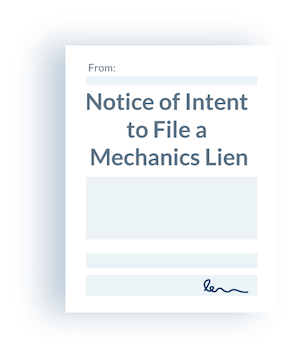
Managing lien rights in the construction industry is already challenging enough without having to remember the specific names for all of the documents that are used in the process. It certainly doesn’t help that each state can have their own name for a particular document. (Thus a preliminary notice is called a “notice to owner” in 12 states including Florida and is known as a “notice of furnishing” in 4 others including Michigan.)
But to help clear up some of this document confusion, we wanted to set the record straight for two of the documents used to manage construction payments – the mechanics lien and the notice of intent to lien.
What’s the difference between these two documents anyway?
Comparing the Documents: Mechanics Lien and the Notice of Intent to Lien
First things first: these two documents are unique and are completely independent from one another. They are used at different times during a payment issue, though both documents have the same goal: to help a project project participant get paid the money they’ve earned.
Let’s discuss the notice of intent to lien first.
Notice of Intent to Lien
The notice of intent to lien is partly a warning notice and partly a demand letter and is used when a customer is delinquent on a construction project. It is sent before a mechanics lien and warns the property owner, prime contractor, and other interested parties that a mechanics lien is will be filed in the immediate future if payment is not received. A notice of intent to lien usually gives these parties between 10-30 days to make payment.
In the majority of states, sending a notice of intent to lien is an optional step (though highly recommended and very effective!), though it is required to be sent before a mechanics lien is filed in the following states:
- Arkansas
- Colorado
- Connecticut
- Louisiana
- Missouri
- North Dakota
- Pennsylvania
- Wisconsin
- Wyoming
The notice of intent to lien is typically sent or served upon the parties – it’s not filed like a mechanics lien. The notice of intent to lien does not bestow any rights upon the party sending it, and it does not impact the property in any way. It is only a warning that something more serious – a lien filing – is coming if the payment issue is not resolved.

Send a Notice of Intent to Lien for Free
We’re the Notice of Intent experts. With us it’s fast, easy, and done right. And it's free.
Send NowFree Download: Notice of Intent Cheat Sheet
Mechanics Lien
Lien rights – and the mechanics lien document – are available in all 50 states nationwide to help contractors, suppliers, and others in the construction business get paid the money they’ve earned.It is not a warning like the notice of intent we described above; a mechanics lien is a demand, and a very powerful one at that. (Here are 17 ways a mechanics lien works to get you paid.)
A mechanics lien is a legal document that is filed (usually in the county recorder’s office) in the state where the project is located. Furthermore, it must be filed within a certain period of time, and these deadlines are strictly enforced.
Summary
Issue | Mechanics Lien | Notice of Intent |
| Is a required document? | YES | Sometimes |
| Must be filed with the recorder’s office? | YES | NO |
| Must meet specific formatting requirements? | YES | Usually Not |
| Must be formally served on certain parties? | Usually | Usually Not |
| Perfects your lien claim? | YES | NO |
| Needs a legal property description? | Usually | Usually Not |

